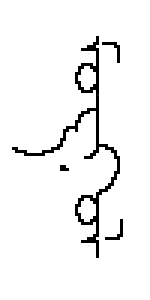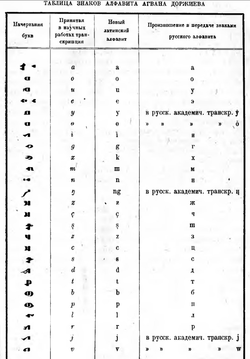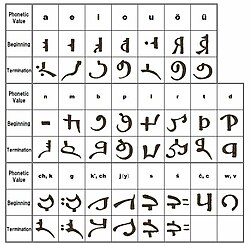Social:Vagindra script
| Vagindra script
вагиндрын үзэглэл Buryat script | |
|---|---|
 "Mongol" in Vagindra | |
| Type | |
| Languages | Buryat, Russian |
| Creator | Agvan Dorzhiev |
| Created | about 1905 |
Time period | in the status of national writing 1905—1910 |
Parent systems | Proto-Sinaitic alphabet
|
Sister systems | Clear script, Manchu script |
The Vagindra script (also spelled Vaghintara, Template:Lang-bua) is an alphabetic script for the Buryat language developed by Agvan Dorzhiev in the first decade of the 20th century. It was used only briefly.
History
Agvan Dorzhiev, or Agvaandorj, a Khory Buryat, developed the script in 1905 with the assistance of Tseveen Jamsrano[1] as a means to cultural unification of the Buryats, naming it "Vagindra" for the Sanskrit version of his name.[2][3] He based it primarily on the Classical Mongol and Todo script,[4] expressing the hope that it would also help Buryats to read materials in the old script.[5] Approximately ten books and pamphlets were published in the script until 1910, using a hybrid dialect primarily based on stern Buryat, but it was not used after that; there was discussion in 1917 of reviving it for use in native schools, but Classical Mongol was thought more likely to foster Mongol unity.[6] Dorzhiev himself apparently lost interest in the project, and neither mentions it nor uses it in his autobiography.[7][8] It was opposed by Mikhail Bogdanov, who advocated rapid assimilation through Russian,[7] and it has been suggested that the hybrid language used presented problems for readers,[8] although evidence suggests otherwise.[7] Probably most importantly, the Tsarist government perceived Mongolian unification, and hence the Vagindra script, as a political threat and exiled some of its proponents.[2][7]
Description
The script is derived primarily from Classical Mongol on the analogy of the Clear script,[9] and like it is written vertically. The version published by Nicolai Amagaev and "Alamzhi-Mergen" (Rinchingiin Elbegdorj) in 1910 consists of 7 vowels and 21 consonants.[5][10] Diacritics are used to indicate long vowels (a vertical line), palatization (a circle), and letters for use in rendering Russian (a dot),[11] including a letter representing the historical Russian double consonant /ʃt͡ʃ/ (corresponding to Cyrillic Щ).[3][12][13] He also added a special letter to mark, Х (h) sound of the Buryat dialect. The alphabet can therefore also be represented as having 36 letters including 8 vowels.[9] Unlike Classical Mongol, the letter forms are invariant regardless of position in the word,[9] being based on the medial forms in Classical Mongol, with the exception of a, which is based on the Uighur script and has a reduced form in medial and final position.[5][11]
References
- ↑ Otgonbayar Chuluunbaatar, Einführung in die mongolischen Schriften, Einführungen in fremde Schriften, Hamburg: Buske, 2008, ISBN:9783875485004, p. 55 (in German)
- ↑ Jump up to: 2.0 2.1 Yeshen-Khorlo Dugarova-Montgomery and Robert Montgomery, "The Buriat Alphabet of Agvan Dorzhiev", in Mongolia in the Twentieth Century: Landlocked Cosmopolitan, ed. Stephen Kotkin and Bruce A. Elleman, Armonck, New York: Sharpe, 1999, ISBN:9780765605368, pp. 79–98, p. 79.
- ↑ Jump up to: 3.0 3.1 "Script, Vagindra", Allen J. K. Sanders, Historical Dictionary of Mongolia, Historical dictionaries of Asia, Oceania, and the Middle East 74, 3rd ed. Lanham, Maryland: Scarecrow, 2010, ISBN:9780810874527.
- ↑ ""www.munkho.de"". https://www.munkho.de/wp/%D0%BC%D0%BE%D0%BD%D0%B3%D0%BE%D0%BB-%D0%B1%D0%B8%D1%87%D0%B3%D0%B8%D0%B9%D0%BD-%D1%81%D0%BE%D1%91%D0%BB-%D1%82%D2%AF%D2%AFx-%D1%83%D1%80%D0%B0%D0%BD-%D0%B1%D0%B8%D1%87%D0%BB%D1%8D%D0%B3-%D0%B1-2/.
- ↑ Jump up to: 5.0 5.1 5.2 Dugarova-Montgomery and Montgomery, p. 85.
- ↑ Dugarova-Montgomery and Montgomery, p. 86.
- ↑ Jump up to: 7.0 7.1 7.2 7.3 Dugarova-Montgomery and Montgomery, p. 88.
- ↑ Jump up to: 8.0 8.1 Chuluunbaatar, p. 57.
- ↑ Jump up to: 9.0 9.1 9.2 BNMAU-yn Shinzhlėkh Ukhaany Akademi, Information Mongolia: The Comprehensive Reference Source of the People's Republic of Mongolia (MPR), Countries of the world information series, Oxford/New York: Pergamon, 1990, ISBN:9780080361932, p. 61.
- ↑ Nikolai Amagaev and Alamzhi-Mergen, Novyi mongolo-buriatskii alfavit, St. Petersburg: Tipografiia Imperatorskoi akademii nauk, 1910, cited in Dugarova-Montgomery and Montgomery, p. 86, Chart 1, p. 87.
- ↑ Jump up to: 11.0 11.1 Chuluunbaatar, p. 56.
- ↑ Chart linked at Luigi Kapaj (in the SCA: Gülügjab Tangghudai), Mongol Scripts, The Silver Horde, Society for Creative Anachronism, 2003.
- ↑ L'écriture Buryat: L’alphabet, chart at Les écritures, Aleph2, archived on 2012-01-27 (in French)
Further reading
- Ëndonzhamt︠s︡yn Zhanchiv and Gonchigiĭn Gantogtokh (Sharaĭd). Vagindra u̇sgiĭn dursgaluud [Monuments in Vagindra script]. Corpus scriptorum VIII. Ulaanbaatar: Udam Soël, 2010. OCLC 773896142 (in Mongolian)
External links
- L'écriture Buryat: Les exemples: example of Vagindra script
- example linked at Luigi Kapaj (in the SCA: Gülügjab Tangghudai), Mongol Scripts, The Silver Horde, Society for Creative Anachronism, 2003.
 |



